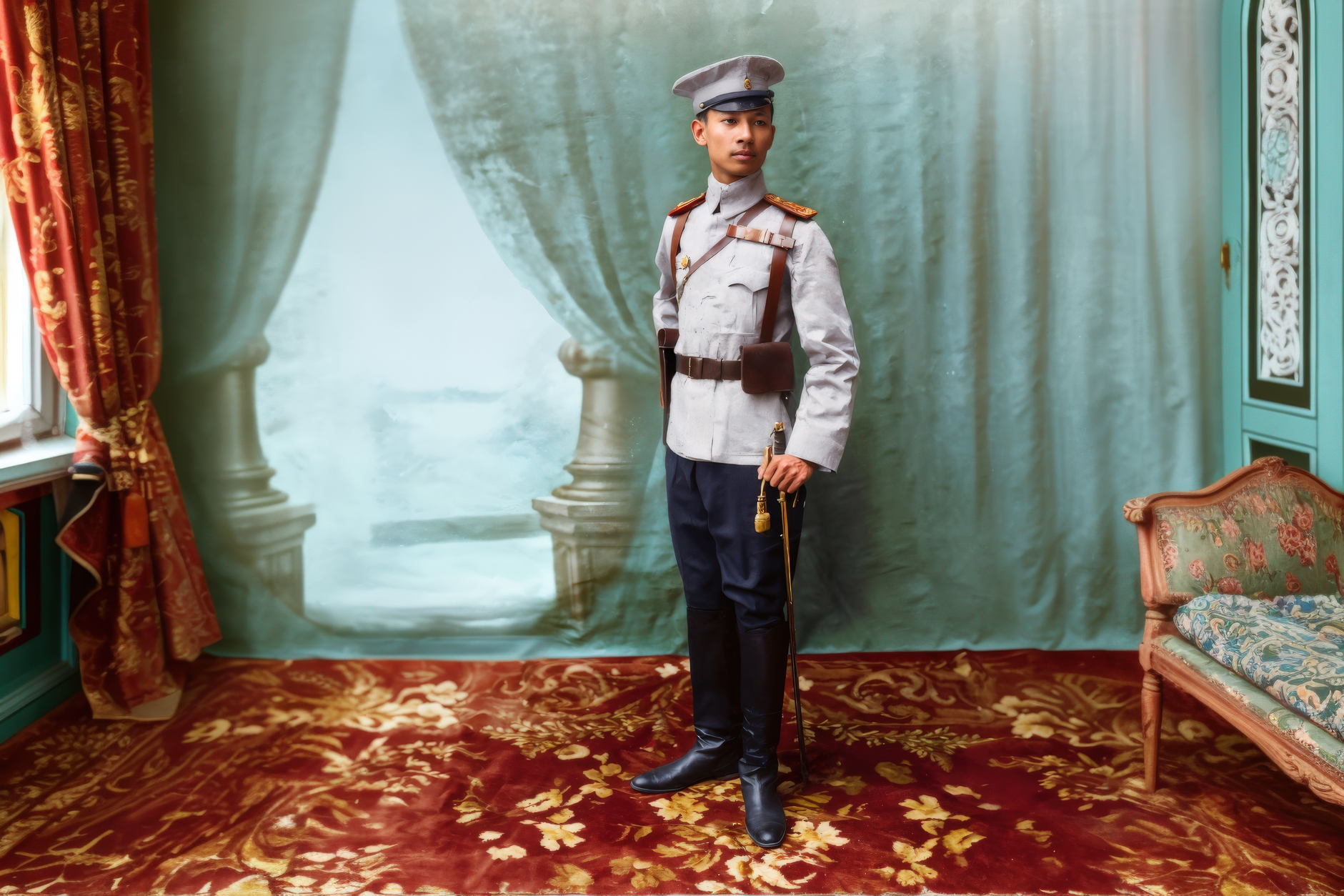เครื่องแบบทหารไทยในสมัยต้นรัชกาลที่ ๖: ก่อนสยามเข้าสู่สงครามโลกครั้งที่ 1
เครื่องแบบทหารไทยในสมัยต้นรัชกาลที่ ๖: ก่อนสยามเข้าสู่สงครามโลกครั้งที่ 1
ชุบชีวิตประวัติศาสตร์: ความร่วมมือกับกลุ่ม 2483 Reenactment Group
ผลงาน AI คอลเลกชันนี้เกิดขึ้นจากความร่วมมืออย่างอบอุ่นกับ กลุ่ม 2483 Reenactment Group https://www.facebook.com/2483RG ซึ่งเป็นชุมชนผู้เชี่ยวชาญด้านประวัติศาสตร์เครื่องแบบทหารสยาม กลุ่มนี้มีบทบาทสำคัญในการให้ความรู้และข้อมูลสำหรับงานค้นคว้าด้านการออกแบบเครื่องแต่งกายสำหรับภาพยนตร์ของผม ซึ่งเรื่องราวอยู่ในช่วงรัชกาลที่ ๖ โดยเน้นช่วงปี พ.ศ. 2456–2462 (ค.ศ. 1913–1919) ซึ่งครอบคลุมช่วงเปลี่ยนผ่านก่อน ระหว่าง และหลังสงครามโลกครั้งที่ 1 และเป็นภาพยนตร์ไทยที่ผมจะได้ร่วมงานด้วย หลังจากที่ทำงานที่ลอนดอนมาเป็นเวลานาน
ในฐานะที่ผมไม่ได้เชี่ยวชาญด้านประวัติศาสตร์เครื่องแต่งกายทหารไทย ผมรู้สึกโชคดีมากที่ได้รู้จักกลุ่มผู้เชี่ยวชาญกลุ่มนี้ในระหว่างที่กำลังค้นคว้าแหล่งข้อมูลอ้างอิงเชิงประวัติศาสตร์ และเป็นเรื่องบังเอิญอย่างยิ่งที่ผมได้พบว่า คุณศุภณัฏฐ์ วงศ์ศิริธร ผู้เชี่ยวชาญหลักของเพจ และผม ได้พูดคุยแลกเปลี่ยนกันทางออนไลน์มาสักพักหนึ่งในเพจ AI Fashion Lab นี้เอง โดยไม่รู้เลยว่าอีกฝ่ายคือใคร เป็นเรื่องบังเอิญที่น่าประหลาดใจในโลกที่เล็กกว่าที่คิดมากครับ
ด้วยความกรุณาของคุณศุภณัฏฐ์ ผมจึงได้รับภาพถ่ายต้นฉบับขาวดำที่มีคุณค่ามาก และคำแนะนำทางวิชาการที่ล้ำค่ายิ่ง ช่วยให้ผมสามารถลงสีภาพขาวดำดั้งเดิมได้อย่างถูกต้องใกล้เคียงกับข้อเท็จจริงทางประวัติศาสตร์ โดยเฉพาะเรื่องโทนสีของเครื่องแบบ สิ่งที่ผมได้เรียนรู้ คือช่วงก่อนการเปลี่ยนแปลงรูปแบบเครื่องแบบในปี พ.ศ. 2457 (ค.ศ. 1914) ซึ่งกองทัพสยามปรับมาใช้เครื่องแบบและสีแบบจักรวรรดิอังกฤษในช่วงที่เข้าร่วมสงครามในประเทศฝรั่งเศส กองทัพยังคงใช้เครื่องแบบสไตล์ “พระราชนิยม” (parachaniyom) ที่ได้รับอิทธิพลจากอังกฤษ จากการศึกษาในประเทศอังกฤษของพระบาทสมเด็จพระมงกุฎเกล้าเจ้าอยู่หัว รัชกาลที่ ๖ เมื่อทรงพระเยาว์
เครื่องแบบทหารสยามในยุคนี้ ประกอบด้วยเสื้อทูนิคและหมวกสีเทา ประดับด้วยอินธนูสีแดงและทอง กางเกงแบบขาสั้นที่เรียกว่า breeches สีกรมท่า สวมคู่กับรองเท้าบู๊ตขี่ม้าสีดำหรือรองเท้าทหารสีดำ และสวมเกเตอร์หนัง(สนับแข้ง) สีน้ำตาลหรือผ้าพันแข้งสีน้ำตาล และสิ่งที่น่าสนใจคือในช่วงปลายรัชกาลที่ ๕ ซึ่งใช้เครื่องแบบสีเทาเช่นเดียวกันนั้น ยังมีทหารชั้นผู้น้อยบางนายที่ไม่ได้รับแจกแม้กระทั่งรองเท้า สะท้อนให้เห็นถึงข้อจำกัดด้านทรัพยากรและความไม่สม่ำเสมอในการปรับตัวเข้าสู่ความเป็นสมัยใหม่ของกองทัพในยุคนั้น เราจะเห็นได้จากภาพอ้างอิงจากภาพต้นฉบับในสมัยนั้นครับ
แม้ว่าเครื่องหมายต่าง ๆ เช่น เข็มกลัดและเหรียญตราจะมีความสำคัญมากเช่นเดียวกับเสื้อผ้า แต่ผมยังไม่ได้รวมองค์ประกอบเหล่านี้ไว้ในโครงการลงสีภาพครั้งนี้ เนื่องจากในระยะนี้ผมมุ่งเน้นเฉพาะในเรื่องของโทนสีของเครื่องแบบเป็นหลัก
ภาพถ่ายสีที่ผ่านการปรับปรุงเหล่านี้ยังถูกนำไปใช้เป็นฐานข้อมูลสำหรับฝึกโมเดล LoRA ซึ่งผมจะนำเสนอผลงานที่เสร็จสมบูรณ์ให้ชมกันในโพสต์ถัดไป สำหรับผู้ที่สนใจในประวัติศาสตร์เครื่องแบบทหาร ภาพชุดนี้ถือเป็นเอกสารอ้างอิงที่ช่วยให้ภาพถ่ายขาวดำในอดีตกลับมามีชีวิตอีกครั้ง
สิ่งที่ผมชื่นชอบเป็นพิเศษเกี่ยวกับการใช้ AI ในการสร้างสรรค์ภาพในบริบทนี้ คือการ AI ไม่ใช่เพียงแค่การสร้างสรรค์ภาพใหม่เท่านั้น แต่คือความสามารถในการปรับแต่งและบูรณะภาพต้นฉบับ และสามารถเป็นอุปการณ์ในการตีความประวัติศาสตร์ในแง่มุมใหม่ เครื่องมืออย่าง Flux Kontext, Midjourney Editing Suite, Krea Edit และ Freepik Edit กลายเป็นเครื่องมือสำคัญในการทำงานของผม ซึ่งช่วยให้เราสามารถลงสี ปรับแต่ง เพิ่มเติมส่วนที่ขาดหายไป หรือสร้างบริบทใหม่ในรูปภาพ และเสริมคุณค่าภาพถ่ายเก่าได้อย่างทรงพลัง ซึ่งเป็นอีกหนึ่งมิติที่ทำให้เราสัมผัสอดีตได้อย่างลึกซึ้งยิ่งขึ้น
ขอขอบพระคุณจากใจจริงมายังคุณศุภณัฏฐ์ สำหรับความรู้ ความเอื้อเฟื้อ และน้ำใจในการให้ข้อมูลและภาพต้นฉบับสำหรับงานค้นคว้าสำหรับการสร้างสรรค์เครื่องแต่งกายสำหรับภาพยนตร์ของผม ความร่วมมือครั้งนี้ไม่เพียงแต่เสริมสร้างองค์ความรู้เท่านั้น แต่ยังเป็นประสบการณ์ที่น่าประทับใจที่เราได้แบ่งปันความชื่นชอบในประวัติศาสตร์เครื่องแต่งกาย และการสร้างสรรค์ผลงานด้วย AI ร่วมกันครับ
Thai Military Uniforms in the Early Reign of King Vajiravudh, Before World War I
Bringing History to Life: A Collaboration with the 2483 Reenactment Group
This AI collection is a heartfelt collaboration with the 2483 Reenactment Group, https://www.facebook.com/2483RG an esteemed community dedicated to the study and preservation of Siamese military uniform history. Their expertise has been invaluable to my ongoing costume design research, which focuses on the era of King Vajiravudh (Rama VI), particularly during the years 1913–1919—a period that spans the transformative years before, during, and after the First World War.
As someone who does not specialise in military history, I was fortunate to be introduced to this remarkable group while searching for accurate references. In a twist of serendipity, I soon discovered that the founder and historical specialist of the page, Khun ศุภณัฏฐ์ วงศ์ศิริธร, and I had already been engaging with one another online for some time—without realising who the other person truly was. A small world indeed.
Thanks to Khun ศุภณัฏฐ์'s kind assistance, I was given access to valuable photographic materials and expert guidance that allowed me to colourise original black-and-white images with a high level of historical accuracy, especially regarding the colours of the uniforms. His insights helped me better understand the stylistic transitions in Siamese military attire during this period.
I learned that before the shift in uniform style in 1914—when Siamese forces adopted British wartime khaki for their involvement in France—the standard military uniform followed the parachaniyom style with British-inspired elements. The tunic and hat were grey, with red and gold epaulettes. Breeches were dark navy, worn with black riding boots or military shoes, and paired with brown gaiters or puttees. Interestingly, during the late reign of King Chulalongkorn (Rama V), when these same grey uniforms were already in use, some lower-ranking soldiers were not even issued shoes—highlighting the limited resources and uneven modernisation of the armed forces at the time.
While pins and decorations were also significant during this period, I have not yet included them in this particular colourisation project, which currently focuses on the overall uniform palette.
These colourised images form the basis for training a LoRA model, and I will share the visual results of this creation in a future post. For those with an interest in historical military uniforms, this set offers a vivid reference—bringing monochrome archives back to life.
What I love most about using AI in this context is not just its power to generate new visuals, but its potential to restore and reinterpret history. Tools such as Flux Kontext, Midjourney Editing Suite, Krea Edit, and Freepik Edit have become essential in my work. With them, we can colourise, edit, and enhance original historical photographs—offering a new dimension to our understanding of the past.
My deepest thanks to Khun ศุภณัฏฐ์ for his expertise and generosity. This collaboration has been both enriching and unexpectedly personal—and I am so grateful for the shared passion that brought it to life.
#aifashionlab #AI #aiartist #aiart #aifashion #aifashiondesign #aifashionstyling #aifashiondesigner #fashion #fashionhistory #historyoffashion #fashionstyling #fashionphotography #digitalfashion #digitalfashiondesign #digitalcostumedesign #digitaldesign #digitalaiart #ThaiFashionHistory #ThaiFashionAI



























































